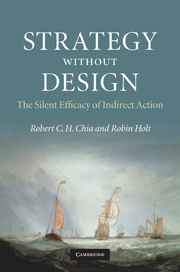Book contents
- Frontmatter
- Contents
- Preface
- Introduction
- 1 Spontaneous order: the roots of strategy emergence
- 2 Economic agency and steps to ecological awareness
- 3 Reconceptualizing agency, self-interest and purposive action
- 4 The ‘practice turn’ in strategy research
- 5 Building and dwelling: two ways of understanding strategy
- 6 Strategy as ‘wayfinding’
- 7 The silent efficacy of indirect action
- Epilogue: Negative capability
- Notes
- Index
2 - Economic agency and steps to ecological awareness
Published online by Cambridge University Press: 22 January 2010
- Frontmatter
- Contents
- Preface
- Introduction
- 1 Spontaneous order: the roots of strategy emergence
- 2 Economic agency and steps to ecological awareness
- 3 Reconceptualizing agency, self-interest and purposive action
- 4 The ‘practice turn’ in strategy research
- 5 Building and dwelling: two ways of understanding strategy
- 6 Strategy as ‘wayfinding’
- 7 The silent efficacy of indirect action
- Epilogue: Negative capability
- Notes
- Index
Summary
[T]he resolution of contraries reveals a world in which personal identity merges into all the processes of relationship in some vast ecology.
Gregory Bateson, Steps to an Ecology of Mind, p.306In chapter 1 we showed how the idea of spontaneous order can account for the emergence of coherent patterns of behaviour as well as centralized planning and design. We traced this idea of spontaneous emergence to the thoughts of ancient philosophers and discussed how subsequent important writers from a variety of backgrounds and disciplines have taken up this argument and elaborated upon it. This eschewal of the necessity for deliberate intention and pre-planning to account for the emergence of social and strategic orders opens up a new and difficult conceptual territory, however, for those looking to explain how it is that we as human beings can come to know about and influence our world under such conditions of uncertainty. If strategy amounts to anything, it is predicated upon a sense of being able to do something, of intervening deliberately to change the course of events in one's favour. If the conditions in which agents act are themselves inherently unstable, however, then there seems little to distinguish between strategic activity and chance and serendipity. This chapter is devoted to the further exploration of this question.
We consider the strategic dangers in deferring to a view of the world in which the individual is construed as an isolate, detached entity who engages with and seeks to control the world around him-/herself – an epistemological stance of methodological individualism.
- Type
- Chapter
- Information
- Strategy without DesignThe Silent Efficacy of Indirect Action, pp. 57 - 90Publisher: Cambridge University PressPrint publication year: 2009



